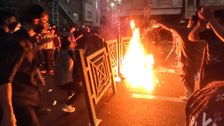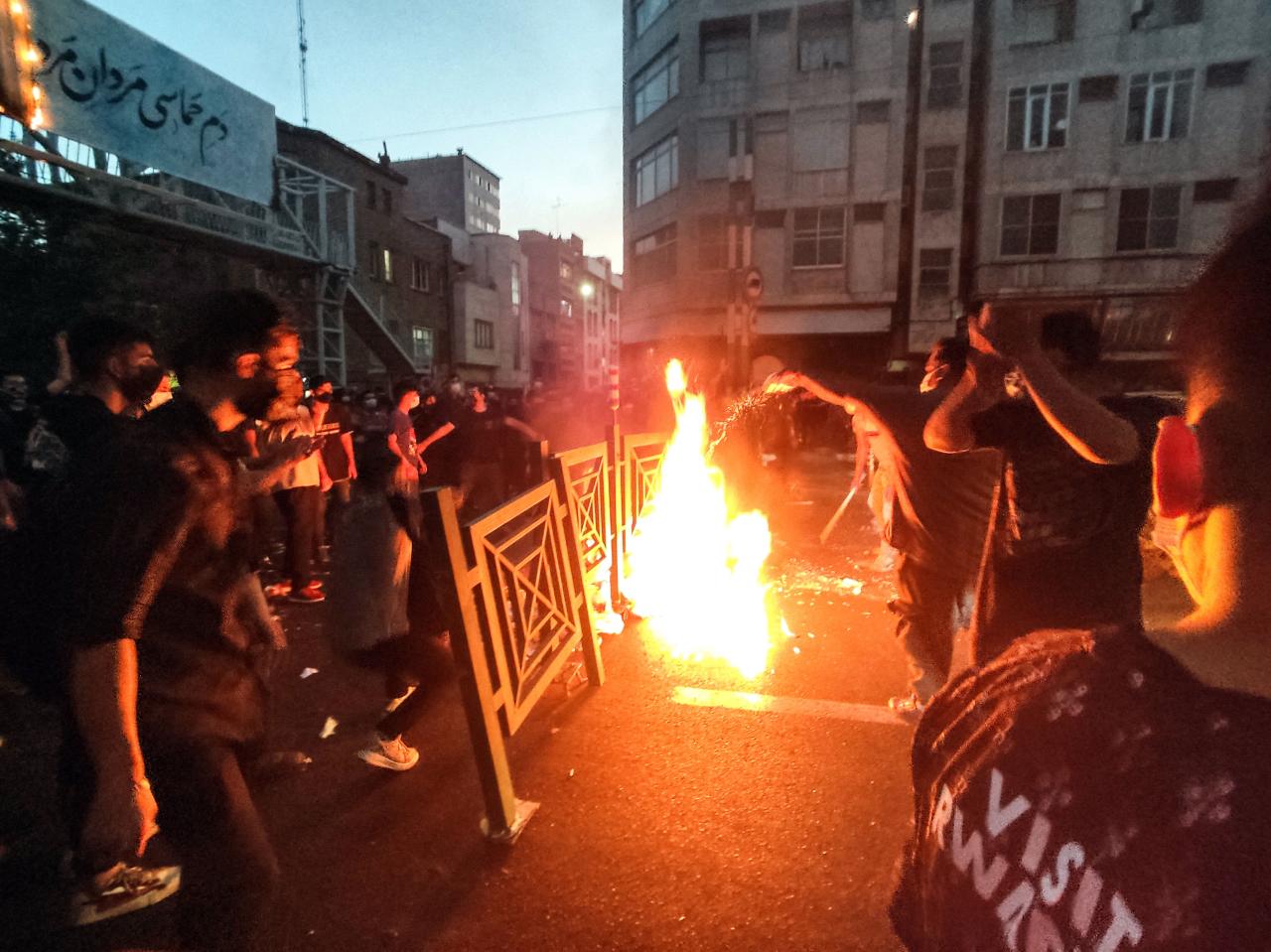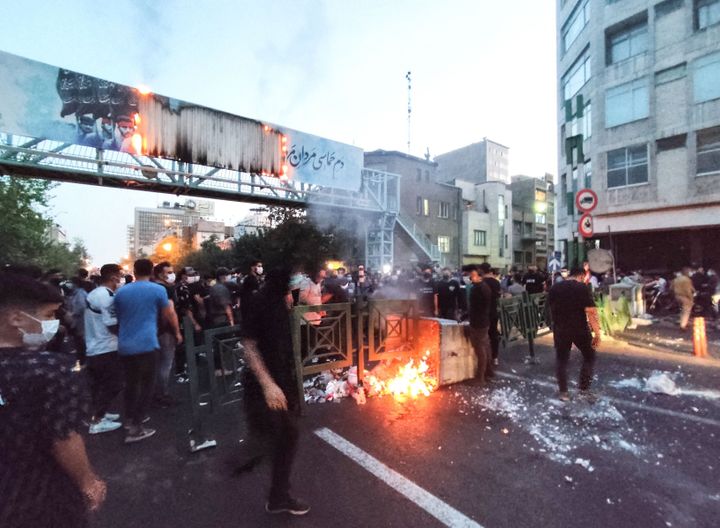DUBAI, United Arab Emirates (AP) — Clashes between Iranian security forces and protesters angry over the death of a 22-year-old woman in police custody have killed at least nine people since the violence erupted over the weekend, according to a tally Thursday by The Associated Press.
The scope of Iran’s ongoing unrest, the worst in several years, still remains unclear as protesters in at least a dozen cities — venting anger over social repression and the country’s mounting crises — continue to encounter security and paramilitary forces.
Advertisement
To prevent protests from spreading, Iran’s biggest telecom operator largely shut down mobile internet access again Thursday, said Netblocks, a group that monitors internet access, describing the restrictions as the most severe since 2019.
An anchor on Iran’s state television suggested the death toll from the mass protests could be as high as 17 on Thursday, but did not say how he reached that figure. “Unfortunately, 17 people and police officers present at the scene of these events lost their lives,” the anchor said, adding official statistics would be released later.
In a country where radio and television stations already are state-controlled and journalists regularly face the threat of arrest, the paramilitary Revolutionary Guard urged the judiciary on Thursday to prosecute “anyone who spreads fake news and rumors” on social media about the unrest. Widespread outages of Instagram and WhatsApp, which are used by protesters, also continued Thursday.
The demonstrations in Iran began as an emotional outpouring over the death of Mahsa Amini, a young woman held by the country’s morality police for allegedly violating its strictly enforced dress code. Her death has sparked sharp condemnation from the United States, the European Union and the United Nations.
Advertisement
Anadolu Agency via Getty Images
The police say she died of a heart attack and was not mistreated, but her family has cast doubt on that account. Independent experts affiliated with the U.N. said Thursday that reports suggested she was severely beaten by the morality police, without offering evidence.
The protests have grown in the last five days into an open challenge to the government, with women removing and burning their state-mandated headscarves in the streets and Iranians calling for the downfall of the Islamic Republic itself.
“Death to the dictator!” has been a common cry in the protests.
Demonstrations have rocked university campuses in Tehran and western cities such as Kermanshah. Although widespread, the unrest appears distinct from earlier rounds of nationwide protests triggered by pocketbook issues.
The protest movement that erupted in 2019 over the government’s gasoline price hike mobilized working class masses in Iran’s towns. Hundreds were killed as security forces cracked down, according to human rights groups, the deadliest violence since the 1979 Islamic Revolution.
Advertisement
Iran’s state-run media this week reported demonstrations in at least 13 cities, including the capital, Tehran. Videos online show security forces firing tear gas and water canons to disperse hundreds of protesters. London-based Amnesty International reported that officers also fired birdshot and beat protesters with batons.
Footage on social media from the northern city of Tabriz shows a young man allegedly shot by security forces bleeding out in the street as protesters shouted for help.
At least nine people have died in the confrontations, according to an AP count based on statements from Iran’s state-run and semiofficial media. In a statement on Thursday, the Guard blamed the unrest on “Iran’s enemies.”
– via Getty Images
In Amini’s home province in the northwest, Kurdistan, the provincial police chief said four protesters were killed by live fire. In Kermanshah, the prosecutor said two protesters were killed, insisting that the bullets were not fired by Iran’s security forces.
Advertisement
Some demonstrators appear to have targeted security forces. Three men affiliated with the Basij, a volunteer force under the Guard, were killed in clashes in the cities of Shiraz, Tabriz and Mashhad, semiofficial media reported, bringing the death toll acknowledged by officials to at least nine on both sides.
The independent experts with the U.N. said the clashes have killed at least eight people, including a woman and 16-year-old boy, with dozens more injured and arrested.
The confrontations have left a trail of destruction. In the northern province of Mazandaran, angry crowds damaged or set fire to over 40 government properties and injured 76 security officers, Rouhollah Solgi, the deputy governor, said.
Iran has grappled with waves of protests in the recent past, mainly over a long-running economic crisis exacerbated by Western sanctions linked to its nuclear program. Citizens also blame government corruption and mismanagement as prices of basic goods soar and the Iranian currency shrivels in value.
The Biden administration and European allies have been working to revive the 2015 Iran nuclear accord, in which Iran curbed its nuclear activities in exchange for sanctions relief, but the talks have been deadlocked for months.
Advertisement
From New York, where Iranian President Ebrahim Raisi took the stage Wednesday at the U.N. General Assembly, CNN’s chief international anchor Christiane Amanpour said she had planned to confront Raisi about the protests roiling Iran in what would be his first U.S.-based interview.
But Amanpour wrote on Twitter that when the interview was due to start, Raisi didn’t show. An aide told her the president refused to take part unless she wore a headscarf given the “situation in Iran.” The Iranian government did not immediately acknowledge her account.
“I couldn’t agree to this unprecedented and unexpected condition,” the British-Iranian anchor wrote beside a photo of Raisi’s empty chair.
“As protests continue in Iran and people are being killed, it would have been an important moment to speak with President Raisi.”
Related posts:
Views: 0
 RSS Feed
RSS Feed
















 September 23rd, 2022
September 23rd, 2022  Awake Goy
Awake Goy 


 Posted in
Posted in  Tags:
Tags: 
















